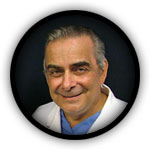Hair Transplant Forum International is the official publication of the International Society of Hair Restoration Surgery (ISHRS), and I’m pleased to announced that I was just named the Pioneer of the Month (Volume 18, Number 1)! The article, written by Dr. Jerry Cooley, is presented below. It serves as part biographical, part information that hasn’t been found elsewhere on the Internet until now. I hope it gives you an insight into my background and goals for the future.
—
 As a young man, Bill Rassman had “one focus in life, to make a difference.” To say he’s made a difference to the specialty of hair restoration may be one of the greatest understatements ever. Creative and controversial, Bill has made his mark and it’s hard to imagine how hair transplantation would have evolved without him. Because of Bill, our lives are very different indeed.
As a young man, Bill Rassman had “one focus in life, to make a difference.” To say he’s made a difference to the specialty of hair restoration may be one of the greatest understatements ever. Creative and controversial, Bill has made his mark and it’s hard to imagine how hair transplantation would have evolved without him. Because of Bill, our lives are very different indeed.
Bill was born in 1942 in New York. He grew up in Brooklyn, the son of Russian immigrants. After medical school in Virginia, he entered general surgery residency at the University of Minnesota and Cornell. This was interrupted by military service in Viet Nam. Before military service, he did a cardiovascular fellowship where he played a key role in pioneering and commercializing the intra-aortic balloon pump. After returning, he finished his surgery residency at Dartmouth. Bill entered private practice in Vermont where he practiced for six years. He then relocated to Hawaii, practicing surgery there for four years.
Feeling bored and in need of adventure, Bill left medicine and became an entrepreneur, starting a company that developed commercial applications for windmills. After this became a multi-million dollar business, he sold the company. With the money he made, Bill funded his next adventure, a start-up computer software company, which did not progress the way he wanted. After four years of working to develop this, he decided to reenter medicine.
 Bill joined Bosley where he soon became its president. Unhappy with the state of hair transplantation at that time, he left Bosley and in 1991 began visiting prominent surgeons, such as Walter Unger and Emmanual Merritt. During this time, he developed his ideas about procedures with large numbers of small grafts, the “megasession.” Bill began doing hair transplants, which in the beginning meant only 400-500 grafts where he did all the cutting and placing himself.
Bill joined Bosley where he soon became its president. Unhappy with the state of hair transplantation at that time, he left Bosley and in 1991 began visiting prominent surgeons, such as Walter Unger and Emmanual Merritt. During this time, he developed his ideas about procedures with large numbers of small grafts, the “megasession.” Bill began doing hair transplants, which in the beginning meant only 400-500 grafts where he did all the cutting and placing himself.
With increasing staff came increasing session sizes. More staff also allowed Bill to focus on further innovations, such as the Densitometer to quantify donor hair and help estimate the number of grafts that could be harvested. It also allowed him to open more offices, including one in New York where he met Bob Bernstein. Together, they developed the concept of using naturally occurring follicular units as the fundamental building block of hair transplantation.
In the mid-90s, Bill’s practice was booming and he was very busy. One issue that became obvious in the “megasession” era was the dependence on large numbers of well-trained staff. To give the surgeon more control over the procedure, Bill began experimenting with follicular unit extraction and new tools to automate the procedure. His interest in FUE continues and he reports that he may introduce a new tool that “reflects a completely new paradigm” for FUE. His interest in automation led to the development of the Carousel Implanter (1997), and instrument he still thinks works great. Unfortunately, he was unsuccessful getting a company to manufacture a reliable instrument.
Bill’s current activities include maintaining his Balding Blog on the Internet, he he daily gets 5,000 visitors and 700 emails. Bill also enjoys writing and is currently working on a book entitled “Hair Loss for Dummies,” which is part of the popular consumer book series.
Another current interest is completely outside the field of hair restoration. Bill is founder of a company (Maven Technologies) focused on “personalized medicine,” with proprietary technology used in a diagnostic instrument to rapidly assay thousands of abnormal proteins, glycoproteins, and disease markers in patients for early disease detection and staging. Eventually, he hopes that this technology will become a backbone instrument used by pharma for the development and testing of new drugs. He refers to this project as one of the most exciting things he’s ever done, which is quite a statement in light of all his career accomplishments.
When he has free time, Bill likes to scuba, ski, read, and compose music on the piano, as well as spend time with his four grown children.


 As a young man, Bill Rassman had “one focus in life, to make a difference.” To say he’s made a difference to the specialty of hair restoration may be one of the greatest understatements ever. Creative and controversial, Bill has made his mark and it’s hard to imagine how hair transplantation would have evolved without him. Because of Bill, our lives are very different indeed.
As a young man, Bill Rassman had “one focus in life, to make a difference.” To say he’s made a difference to the specialty of hair restoration may be one of the greatest understatements ever. Creative and controversial, Bill has made his mark and it’s hard to imagine how hair transplantation would have evolved without him. Because of Bill, our lives are very different indeed. Bill joined Bosley where he soon became its president. Unhappy with the state of hair transplantation at that time, he left Bosley and in 1991 began visiting prominent surgeons, such as Walter Unger and Emmanual Merritt. During this time, he developed his ideas about procedures with large numbers of small grafts, the “megasession.” Bill began doing hair transplants, which in the beginning meant only 400-500 grafts where he did all the cutting and placing himself.
Bill joined Bosley where he soon became its president. Unhappy with the state of hair transplantation at that time, he left Bosley and in 1991 began visiting prominent surgeons, such as Walter Unger and Emmanual Merritt. During this time, he developed his ideas about procedures with large numbers of small grafts, the “megasession.” Bill began doing hair transplants, which in the beginning meant only 400-500 grafts where he did all the cutting and placing himself.
 In continuing with the theme from yesterday of old links I forgot to post sooner…
In continuing with the theme from yesterday of old links I forgot to post sooner… This was sent to me months ago and I forgot to post it!
This was sent to me months ago and I forgot to post it!